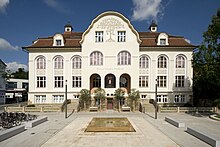Phyletic Museum
The Phyletic Museum is a museum on phylogenesis founded by Ernst Haeckel in Jena .
The Phyletic Museum has 17,000 visitors annually. The permanent exhibition includes the evolution hall (including pigeon races, AIDS, cichlids, ontogenesis of amphibians) as well as several rooms on the tribal history of multicellular animals including humans. Subjects of special exhibitions were domestication , diatoms - sense of form , the smaller majority - photos by Pjotr Naskrecki , insects & sex and biological invasions .
history
The foundation stone of the museum was laid on August 28, 1907, the anniversary of the birthday of Johann Wolfgang von Goethe . Ernst Haeckel donated the building to the Friedrich Schiller University Jena on July 30, 1908, on the occasion of its 350th anniversary. The Phyletic Museum was built with funds from the Carl Zeiss Foundation and initially did not house an exhibition. The first permanent exhibition was opened in 1912 by Ludwig Plate , who had followed Haeckel as museum director in 1909.
Right from the start, it shouldn't just be a natural history museum , it should convey the development of life. To this day, the presentation of phylogenesis (tribal history) and the theory of evolution together with the encounter between art and nature is the main concern of the Phyletic Museum. Today the museum is part of the Institute for Special Zoology and Evolutionary Biology at the University of Jena. It houses extensive zoological - paleontological collections with over 500,000 items. The history of the collection goes back to the 18th century. There are still original pieces from the time when Goethe was the head of the anatomical-zoological collection. The museum's collections serve as the basis for the institute's research, including the anatomy of dogs and other mammals, the morphology, tribal history and biological diversity of insects .
architecture
The building of the museum is built in Art Nouveau style. The architect was Carl Dittmar , who made plans based on ideas and sketches from Haeckel. Today the building is a cultural monument . The facade was renovated in 2007–2008 in accordance with a listed building. Many of the ornaments destroyed at the end of the 1950s were faithfully restored, including details from the 'Tree of Life' in the gable field with the terms “ phylogeny ” and “ ontogeny ” coined by Haeckel in Jena . The 'Medusensaal' with ceiling paintings by Adolf Giltsch based on models by Ernst Haeckel was also restored in the mid-1990s. The square in front of the museum was renovated in 2011–2012 and provided with a fountain.
literature
- H. Penzlin (ed.): History of zoology in Jena according to Haeckel (1909–1974). Gustav Fischer Verlag, 1994, ISBN 3-334-60835-2 .
- MS Fischer, G. Brehm, U. Hoßfeld: The Phyletic Museum in Jena. Institute for Special Zoology, 2008, ISBN 978-3-9811758-3-7 .
Web links
Coordinates: 50 ° 55 ′ 27 ″ N , 11 ° 35 ′ 1 ″ E


